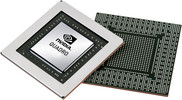NVIDIA Quadro P1000 vs NVIDIA RTX 4000 Ada Generation Laptop GPU vs NVIDIA Quadro P4000 Max-Q
NVIDIA Quadro P1000
► remove from comparison
The Nvidia Quadro P1000 is a mobile entry-level workstation graphics card for notebooks. Similar to the consumer GeForce GTX 1050 (Laptop), it is based on the GP107 chip but offers only 512 shaders (1050 offers 640, 1050 Ti 768). The graphics card is designed for the Kaby Lake / Coffee Lake generation.
The Quadro GPUs offer certified drivers, which are optimized for stability and performance in professional applications (CAD, DCC, medical, prospection, and visualizing applications). The performance in these areas is therefore much better compared to corresponding consumer GPUs.
Performance
The theoretical performance should be below the GeForce GTX 1050 due to the lower shader count.
NVIDIA RTX 4000 Ada Generation Laptop GPU
► remove from comparison
The Nvidia RTX 4000 Ada Generation, not to be confused with the A4000, P4000 or RTX 4000 Turing Generation, is a very powerful professional graphics card for use in laptops that sports 7,424 CUDA cores and 12 GB of ECC GDDR6 VRAM. Brought into existence in 2023, this graphics adapter leverages TSMC's 5 nm process and Nvidia's Ada Lovelace architecture to achieve great performance combined with moderate power consumption. The Nvidia-recommended TGP range for the card is very wide at 60 W to 175 W leading to bizarre performance differences between different systems powered by what is supposed to be the same product.
Hardware-wise, the RTX 4000 is a GeForce RTX 4080 Laptop in disguise. Consequently, both make use of the AD103 chip and have little difficulty running triple-A games at QHD 1440p.
Quadro series graphics cards ship with much different BIOS and drivers than GeForce cards and are targeted at professional users rather than gamers. Commercial product design, large-scale calculations, simulation, data mining, 24 x 7 operation - if any of this sounds familiar, then a Quadro card will make you happy.
Architecture and Features
Ada Lovelace brings a range of improvements over older graphics cards utilizing the outgoing Ampere architecture. It's not just a better manufacturing process and a higher number of CUDA cores that we have here (up to 16,384 versus 10,752); under-the-hood refinements are plentiful, including an immensely larger L2 cache and an optimized ray tracing routine (a different way to determine what is transparent and what isn't is used) and other changes. Naturally, these graphics cards can both encode and decode some of the most widely used video codecs, AVC, HEVC and AV1 included; they also support a host of Nvidia technologies, including Optimus and DLSS 3, and they can certainly be used for various AI tasks.
The RTX 4000 features 58 RT cores of the 3rd generation, 232 Tensor cores of the 4th generation and 7,424 CUDA cores, making it a lot faster than the RTX 3500 Ada Generation. Elsewhere, the graphics card comes with 12 GB of 192-bit wide ECC GDDR6 memory for a very healthy throughput of ~432 GB/s. Error correction can be turned off if desired. The fact that error correction is present here proves that the RTX 4000 is indeed targeted at professional users.
Just like Ampere-based cards, the RTX 4000 makes use of the PCI-Express 4 protocol. 8K SUHD monitors are supported, however DP 1.4a video outputs can potentially prove to be a bottleneck down the line.
Performance
With its power target set to ~130 W, the Ada Generation graphics card delivers a Blender Classroom v3.3 CUDA score of 22 seconds which is a very good result. All 2024 games are playable at 1440p with the highest settings possible on this GPU.
Nvidia's marketing materials mention "up to 33.5 TFLOPS" of performance which is pretty impressive. The RTX 5000 Ada Generation is good for a little over 42 TFLOPS, for reference.
Your mileage may vary depending on how competent the cooling solution of your laptop is and how high the TGP power target of the RTX 4000 is. One other thing worth mentioning is that enabling error correction appears to reduce the amount of video memory that is available to applications and games by up to a gigabyte.
Power consumption
Nvidia no longer divides its laptop graphics cards into Max-Q and non-max-Q models. Instead, laptop makers are free to set the TGP according to their needs, and the range can sometimes be shockingly wide. This is the case with the RTX 4000, as the lowest value recommended for it sits at just 60 W while the highest is more than two times higher at 175 W (this most likely includes Dynamic Boost). The slowest system built around an RTX 4000 Ada can easily be 60% slower than the fastest one. This is the kind of delta that we've already seen on consumer-grade laptops featuring the latest GeForce RTX cards.
Last but not the least, the improved 5 nm process (TSMC 4N) the RTX 4000 Ada is built with makes for very decent energy efficiency, as of mid 2023.
NVIDIA Quadro P4000 Max-Q
► remove from comparison
The Nvidia Quadro P4000 Max-Q (official Nvidia Quadro P4000 with Max-Q Design) is a mobile high-end workstation graphics card for notebooks. There is currently no consumer counterpart and the GPU is sitting between the Quadro P3000 (GTX 1060) and Quadro P5000 (GTX 1070). It is equipped with 1792 shaders and should therefore use the same GP104 chip from the P5000 (2048 shaders). The Max-Q version is a power efficient variant of the normal Quadro P4000 with lower clock rates (1113 - 1240 versus 1202 - ?) and a much reduced power consumption (80 versus 100 Watt TGP).
The Quadro GPUs offer certified drivers, which are optimized for stability and performance in professional applications (CAD, DCC, medical, prospection, and visualizing applications). The performance in these areas is therefore much better compared to corresponding consumer GPUs.
| NVIDIA Quadro P1000 | NVIDIA RTX 4000 Ada Generation Laptop GPU | NVIDIA Quadro P4000 Max-Q | ||||||||||||||||||||||||||||||||||||||||||||||||||||||||||||||||||||||||||||||||||||||||||||||||||||
| Quadro P Series |
|
|
| |||||||||||||||||||||||||||||||||||||||||||||||||||||||||||||||||||||||||||||||||||||||||||||||||||
| Architecture | Pascal | Ada Lovelace | Pascal | |||||||||||||||||||||||||||||||||||||||||||||||||||||||||||||||||||||||||||||||||||||||||||||||||||
| Pipelines | 512 - unified | 7424 - unified | 1792 - unified | |||||||||||||||||||||||||||||||||||||||||||||||||||||||||||||||||||||||||||||||||||||||||||||||||||
| Core Speed | 1493 - 1519 (Boost) MHz | 1113 - 1240 (Boost) MHz | ||||||||||||||||||||||||||||||||||||||||||||||||||||||||||||||||||||||||||||||||||||||||||||||||||||
| Memory Speed | 6008 MHz | 16000 effective = 2000 MHz | 6006 MHz | |||||||||||||||||||||||||||||||||||||||||||||||||||||||||||||||||||||||||||||||||||||||||||||||||||
| Memory Bus Width | 128 Bit | 192 Bit | 256 Bit | |||||||||||||||||||||||||||||||||||||||||||||||||||||||||||||||||||||||||||||||||||||||||||||||||||
| Memory Type | GDDR5 | GDDR6 | GDDR5 | |||||||||||||||||||||||||||||||||||||||||||||||||||||||||||||||||||||||||||||||||||||||||||||||||||
| Max. Amount of Memory | 4 GB | 12 GB | 16 GB | |||||||||||||||||||||||||||||||||||||||||||||||||||||||||||||||||||||||||||||||||||||||||||||||||||
| Shared Memory | no | no | no | |||||||||||||||||||||||||||||||||||||||||||||||||||||||||||||||||||||||||||||||||||||||||||||||||||
| API | DirectX 12_1, Shader 5.0, OpenGL 4.6 | DirectX 12 Ultimate, Shader 6.7, OpenGL 4.6, OpenCL 3.0, Vulkan 1.3 | DirectX 12_1, Shader 5.0, OpenGL 4.5 | |||||||||||||||||||||||||||||||||||||||||||||||||||||||||||||||||||||||||||||||||||||||||||||||||||
| Power Consumption | 40 Watt | 150 Watt (60 - 150 Watt TGP) | 80 Watt | |||||||||||||||||||||||||||||||||||||||||||||||||||||||||||||||||||||||||||||||||||||||||||||||||||
| Transistors | 3.3 Billion | |||||||||||||||||||||||||||||||||||||||||||||||||||||||||||||||||||||||||||||||||||||||||||||||||||||
| technology | 14 nm | 5 nm | 16 nm | |||||||||||||||||||||||||||||||||||||||||||||||||||||||||||||||||||||||||||||||||||||||||||||||||||
| Features | Optimus, PhysX, 3D Vision Pro, nView, Optimus | Optimus, PhysX, 3D Vision Pro, nView, Optimus | ||||||||||||||||||||||||||||||||||||||||||||||||||||||||||||||||||||||||||||||||||||||||||||||||||||
| Notebook Size | large | large | large | |||||||||||||||||||||||||||||||||||||||||||||||||||||||||||||||||||||||||||||||||||||||||||||||||||
| Date of Announcement | 01.02.2017 | 21.03.2023 | 11.01.2017 | |||||||||||||||||||||||||||||||||||||||||||||||||||||||||||||||||||||||||||||||||||||||||||||||||||
| Link to Manufacturer Page | www.nvidia.com | images.nvidia.com | www.nvidia.com | |||||||||||||||||||||||||||||||||||||||||||||||||||||||||||||||||||||||||||||||||||||||||||||||||||
| Raytracing Cores | 58 | |||||||||||||||||||||||||||||||||||||||||||||||||||||||||||||||||||||||||||||||||||||||||||||||||||||
| Tensor / AI Cores | 232 | |||||||||||||||||||||||||||||||||||||||||||||||||||||||||||||||||||||||||||||||||||||||||||||||||||||
| Theoretical Performance | 33.6 TFLOPS FP32 | |||||||||||||||||||||||||||||||||||||||||||||||||||||||||||||||||||||||||||||||||||||||||||||||||||||
| Memory Bandwidth | 432 GB/s | |||||||||||||||||||||||||||||||||||||||||||||||||||||||||||||||||||||||||||||||||||||||||||||||||||||
| PCIe | 4.0 x16 | |||||||||||||||||||||||||||||||||||||||||||||||||||||||||||||||||||||||||||||||||||||||||||||||||||||
| Displays | 4 Displays (max.), HDMI 2.1, DisplayPort 1.4a | |||||||||||||||||||||||||||||||||||||||||||||||||||||||||||||||||||||||||||||||||||||||||||||||||||||
| Predecessor | RTX A3000 Laptop GPU | |||||||||||||||||||||||||||||||||||||||||||||||||||||||||||||||||||||||||||||||||||||||||||||||||||||
| Codename | N17E-Q3 Max-Q |
Benchmarks
3DM Vant. Perf. total + NVIDIA Quadro P1000
specvp11 snx-01 + NVIDIA Quadro P1000
specvp12 sw-03 + NVIDIA Quadro P1000
Cinebench R15 OpenGL 64 Bit + NVIDIA Quadro P1000
GFXBench T-Rex HD Offscreen C24Z16 + NVIDIA Quadro P1000
Average Benchmarks NVIDIA Quadro P1000 → 100% n=14
Average Benchmarks NVIDIA RTX 4000 Ada Generation Laptop GPU → 494% n=14
Average Benchmarks NVIDIA Quadro P4000 Max-Q → 187% n=14
* Smaller numbers mean a higher performance
1 This benchmark is not used for the average calculation
Game Benchmarks
The following benchmarks stem from our benchmarks of review laptops. The performance depends on the used graphics memory, clock rate, processor, system settings, drivers, and operating systems. So the results don't have to be representative for all laptops with this GPU. For detailed information on the benchmark results, click on the fps number.

Baldur's Gate 3
2023
F1 22
2022
FIFA 19
2018
F1 2018
2018
Far Cry 5
2018
X-Plane 11.11
2018
Call of Duty WWII
2017
Ark Survival Evolved
2017
F1 2017
2017
Dirt 4
2017
Rocket League
2017
Prey
2017
For Honor
2017
Resident Evil 7
2017
Battlefield 1
2016
Civilization 6
2016
Mafia 3
2016
Doom
2016
Rainbow Six Siege
2015
Just Cause 3
2015
Fallout 4
2015
Metal Gear Solid V
2015
Dota 2 Reborn
2015
The Witcher 3
2015
GTA V
2015
Ryse: Son of Rome
2014
Alien: Isolation
2014
Thief
2014
Company of Heroes 2
2013
Metro: Last Light
2013
BioShock Infinite
2013
Batman: Arkham City
2011Average Gaming NVIDIA Quadro P1000 → 100%
Average Gaming 30-70 fps → 100%
Average Gaming NVIDIA RTX 4000 Ada Generation Laptop GPU → 519%
Average Gaming NVIDIA Quadro P4000 Max-Q → 190%
Average Gaming 30-70 fps → 231%
| NVIDIA Quadro P1000 | NVIDIA RTX 4000 Ada Generation Laptop GPU | NVIDIA Quadro P4000 Max-Q | |||||||||||||||||||
|---|---|---|---|---|---|---|---|---|---|---|---|---|---|---|---|---|---|---|---|---|---|
| low | med. | high | ultra | QHD | 4K | low | med. | high | ultra | QHD | 4K | low | med. | high | ultra | QHD | 4K | ||||
| Cyberpunk 2077 2.2 Phantom Liberty | 129.3 | 115.1 | 108.4 | 98.3 | 68.5 | ||||||||||||||||
| Baldur's Gate 3 | 178.3 | 160.6 | 141.6 | 137 | 90.7 | ||||||||||||||||
| F1 22 | 275 | 264 | 238 | 95.5 | 65.7 | ||||||||||||||||
| Tiny Tina's Wonderlands | 275.4 | 232.6 | 171.4 | 137.1 | 92 | ||||||||||||||||
| Strange Brigade | 452 | 372 | 323 | 292 | 210 | ||||||||||||||||
| Far Cry 5 | 64 | 32 | 29 | 27 | 168 | 148 | 138 | 128 | 125 | ||||||||||||
| X-Plane 11.11 | 166.8 | 144 | 113.1 | ||||||||||||||||||
| Final Fantasy XV Benchmark | 51.9 | 25.3 | 18.2 | 207 | 185.3 | 150 | 119.5 | ||||||||||||||
| Dota 2 Reborn | 215.4 | 189.7 | 185.2 | 164.4 | |||||||||||||||||
| GTA V | 185.8 | 183.9 | 179.4 | 125.6 | 118.7 | ||||||||||||||||
| NVIDIA Quadro P1000 | NVIDIA RTX 4000 Ada Generation Laptop GPU | NVIDIA Quadro P4000 Max-Q | |||||||||||||||||||
| low | med. | high | ultra | QHD | 4K | low | med. | high | ultra | QHD | 4K | low | med. | high | ultra | QHD | 4K | < 30 fps < 60 fps < 120 fps ≥ 120 fps | 1 1 | 1 1 | 2 | 1 | | | < 30 fps < 60 fps < 120 fps ≥ 120 fps | 10 | 1 9 | 2 8 | 2 6 | 6 2 | | < 30 fps < 60 fps < 120 fps ≥ 120 fps | | | | | | |
For more games that might be playable and a list of all games and graphics cards visit our Gaming List
























